Whether we are dining on Bun Cha in Hanoi or slurping up a delicious bowl of Pho in Saigon, one of our favorite parts of Vietnamese cuisine is the abundance of fresh herbs. But if it’s your first time dining in Vietnam, the heaping pile of fresh greens alongside your meal can be more overwhelming than inviting.
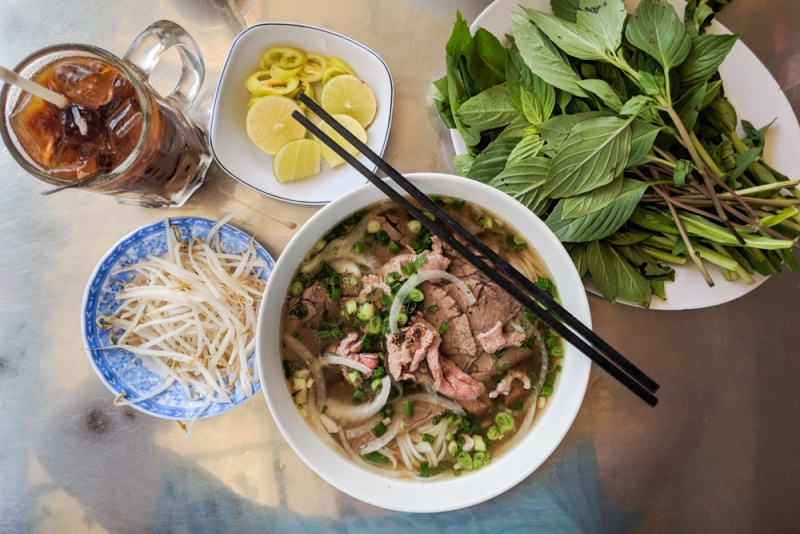
After hundreds of meals in Vietnam, dozens of trips to local markets, and even a couple of Vietnamese cooking classes, we are finally starting to understand all the varieties of fresh Vietnamese herbs.
If you want to become a more adventurous eater in Vietnam and start seasoning your Vietnamese food to perfection, then one of the best places to begin is by understanding the herbs that you’ll be served with each dish.
In this post, we’ll cover what different Vietnamese herbs look like, what they taste like, and what they are called in both English and Vietnamese.
Don’t forget to check out our web story: A Guide to Vietnamese Herbs!
Disclaimer: This post may contain affiliate links. If you make a purchase or booking through one of our links we may earn a small commission (don’t worry, it’s at no extra cost to you).
Guide to Identifying and Eating Vietnamese Herbs
Coriander (Cilantro) – Rau Mùi or Ngò
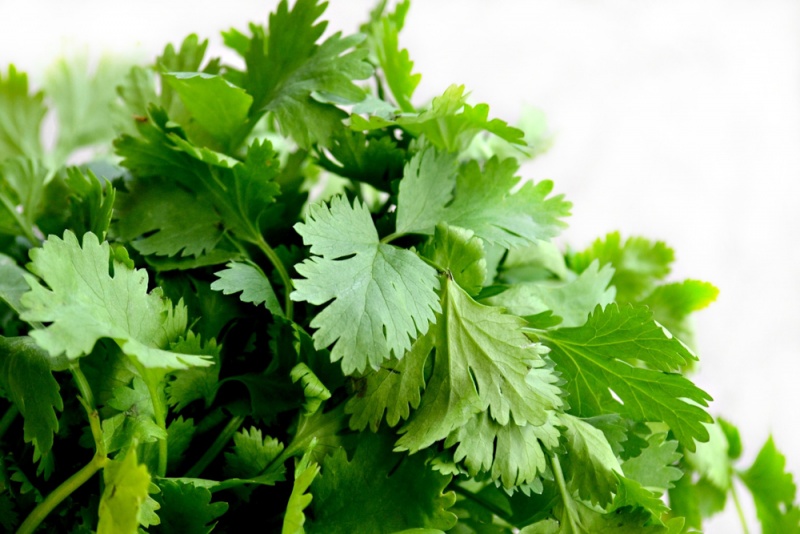
The coriander that is used throughout the Western world is also known as “Chinese coriander” or “Chinese parsley”. And if you’re from North America, you probably call it “cilantro”.
Coriander is very prevalent in Vietnamese cuisine, particularly on banh mi (bánh mì) sandwiches, sprinkled on top of pho (phở), and mixed in with many fresh salads. You probably already know what cilantro looks and tastes like. If not, you can expect a fresh, citrus flavor with a spicy finish. It’s an easily identified herb with its small sprigs of delicate bright green leaves.
Of course, some people think coriander tastes like soap or dirty feet. So if you’re wondering how to say “No coriander” in Vietnamese just say “không rau mùi” if you’re in northern Vietnam and “không rau ngò” if you’re in southern Vietnam.
There are a number of different words for cilantro in Vietnamese, including “rau mùi”, “rau ngò”, “ngò mùi”, and “ngò rí”. “Rau mùi” is more common in Hanoi and northern Vietnam, whereas “rau ngò” or just “ngò” is more common in Saigon and southern Vietnam.
Vietnamese Coriander – Rau Răm
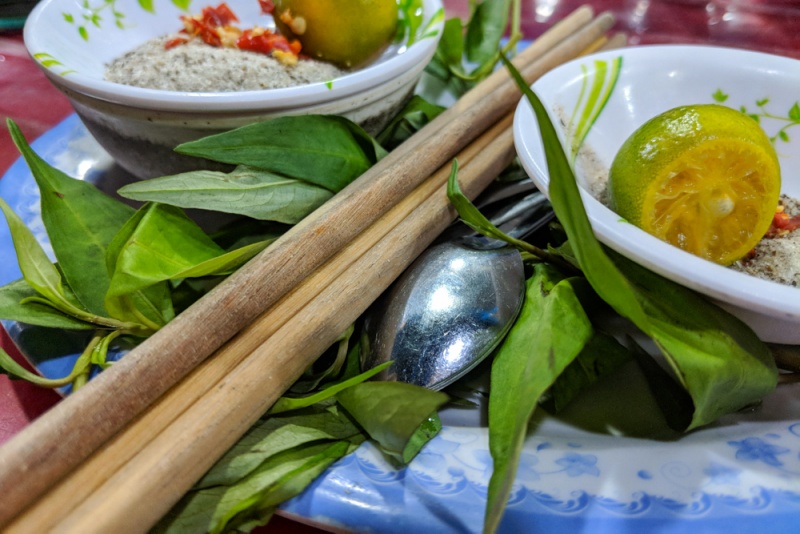
The Vietnamese coriander actually looks and tastes nothing like Chinese coriander (cilantro), so you don’t have to worry about getting the two confused.
The Vietnamese coriander has long, thin, pointy leaves with smooth (non-serrated) edges. The taste is a mix of citrus and mint with a bit of spice which is why it is often called “Vietnamese mint” or”hot mint”.
Vietnamese coriander is very commonly served with sea snails and shellfish in Vietnam. If you head to Vinh Khahn street in Ho Chi Minh City for a lively night of eating snails and drinking beer, the first thing to land on your table will likely be a plate full of Vietnamese coriander.
Culantro – Ngò Gai
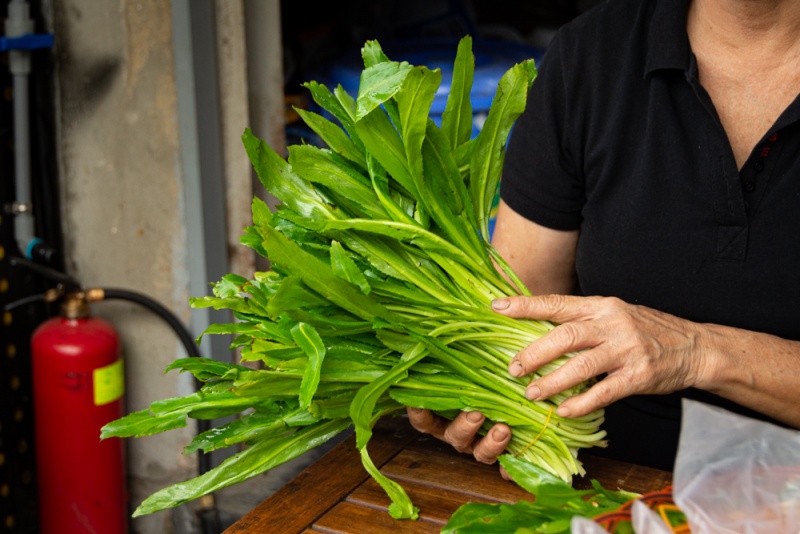
The culantro is yet another coriander-style herb that has its own distinct look and taste. It has a distinct appearance – long, sharply-serrated leaves that resemble a saw blade. It’s actually commonly referred to as a “sawtooth herb”.
The flavor is similar to Chinese coriander but stronger. Culantro’s flavor also holds up better to heat so while cilantro is almost always served fresh, culantro can be added during the cooking of a dish or it can be added at the very end.
If you’re in southern Vietnam, you’ll often find a few culantro leaves served alongside your bowl of pho (phở). If you want to look like a local then make sure to tear the leaves into pieces before adding them to your broth.
Vietnamese Perilla – Tiá Tô
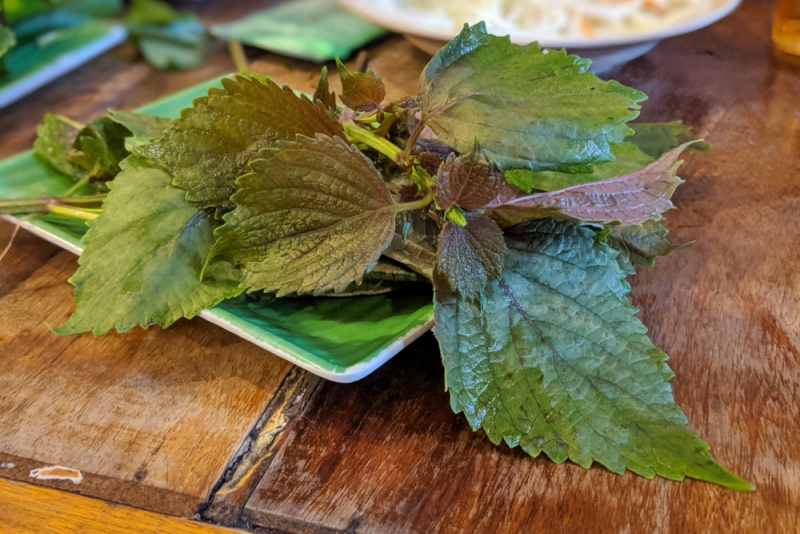
Perilla (also known as shiso) is one of our favorite herbs we have discovered in Vietnam. It has a subtle earthy taste that pairs perfectly with Vietnamese dishes like banh xeo (bánh xèo) and bun cha (bún chả). It’s also a favorite addition to fresh rolls and spring rolls.
Perilla is easy to identify which is always nice when you’re digging through a giant plate of Vietnamese herbs. It has large, wide purple and green leaves with serrated edges.
Perilla can look a bit similar to Vietnamese balm. But perilla has larger leaves, and the distinct purple color always makes perilla easy to spot.
Fish Mint or Heart Leaf – Diếp Cá
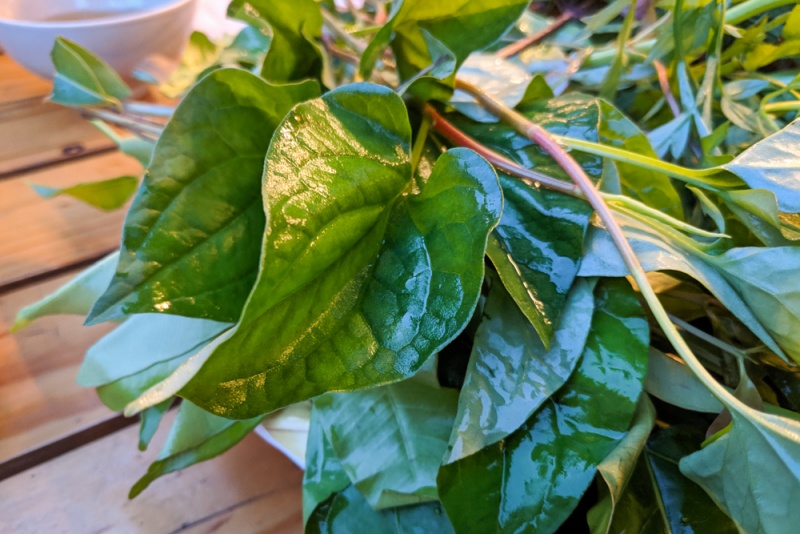
The fish mint is one of the stranger herbs that you’ll encounter in Vietnam. It tastes sour and smells rather fishy. It will probably be a bit off-putting if it’s your first time trying it.
Fish mint has a distinct heart-shaped leaf with a shiny top. You’ll find fish mint served alongside banh xeo (bánh xèo), bo la lot (bò lá lốt), and cao lầu noodles (a specialty of Hoi An). We usually avoid eating fish mint, but perhaps you’ll fall in love with this fishy Vietnamese herb!
Vietnamese Balm – Kinh Giới
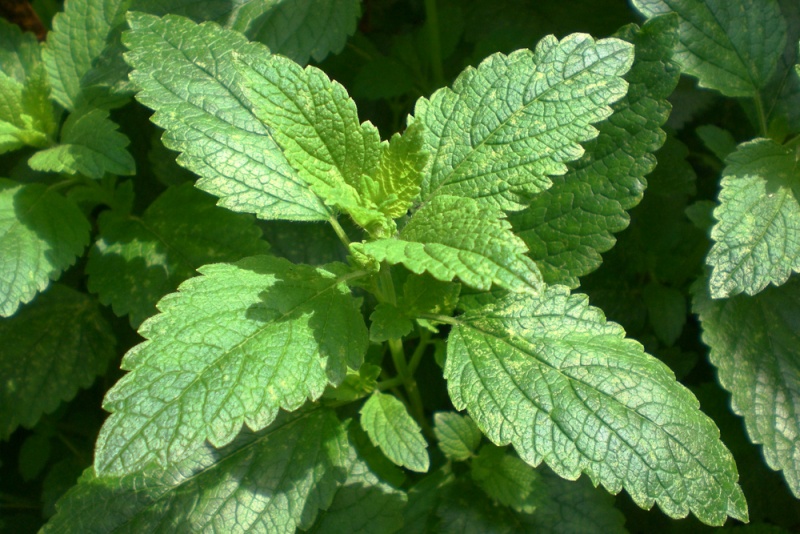
The Vietnamese balm (also known as lemon balm) is a common addition to Vietnamese fresh rolls (gỏi cuốn) or served alongside bun cha (bún chả). It has a bright lemon flavor with a hint of mint. It looks like a larger mint leaf, but the serrations on the leaves are more rounded than pointy.
Vietnamese Balm is quite tasty and helps balance the fatty pork in bun cha with its light citrus flavor.
Thai Basil – Húng Quế
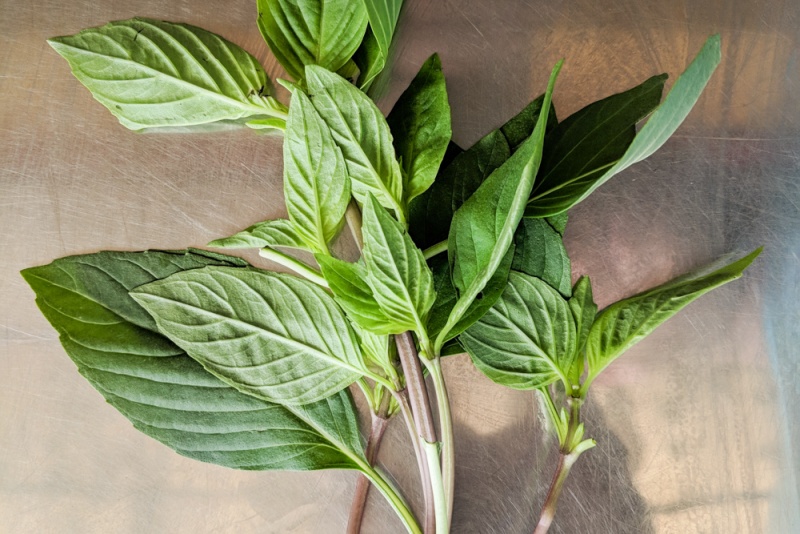
If you think that you’re already familiar with basil, you’re probably thinking of sweet Italian basil that is used to flavor tomato-based pasta sauces or make pesto.
But Thai basil is a bit different, both in taste and appearance. The leaves are more narrow and pointy as well as being slightly serrated. You’ll also notice that the stems are purple.
And the most important difference is in the smell and taste. Thai basil smells a bit like anise and licorice which makes it a perfect accompaniment to Vietnamese pho (phở), banh xeo (bánh xèo), bo la lot (bò lá lốt), and heaps of other Vietnamese dishes.
Peppermint – Húng Cây
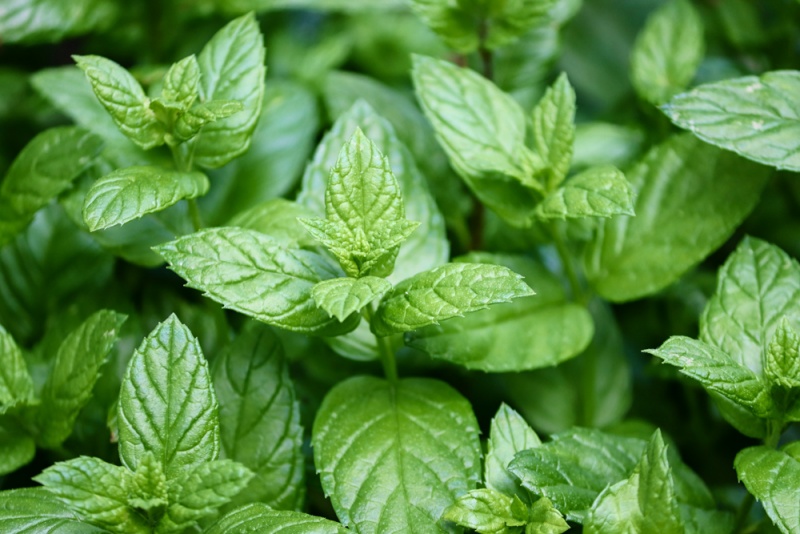
Peppermint has a strong, spicy, mint flavor which is why it’s called peppermint. It’s the mint you’re familiar with from candy canes or other minty sweets around the holidays. The bright green leaves are pointy with slightly serrated edges. They have a strong mint smell and are easy to identify.
Both peppermint and spearmint are quite common in Vietnamese cuisine. They are added to fresh rolls (gỏi cuốn) as a complimentary flavor to the pork and shrimp. They are also heavily featured in Vietnamese salads. You’ll find a few sprigs on one or the other in almost every basket of fresh herbs you are served in Vietnam.
Spearmint – Húng Lủi
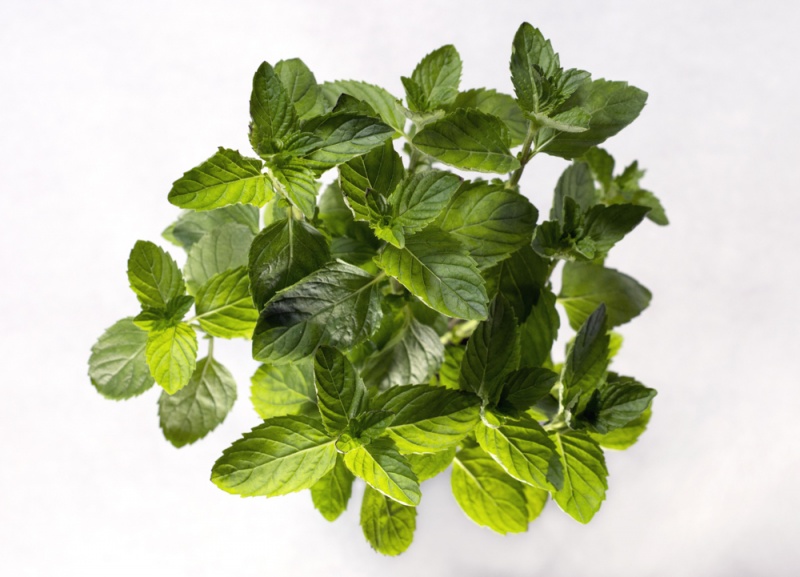
Spearmint is a much milder and more delicate mint flavor than peppermint – it’s more sweet than spicy. It’s the mint that you might use to flavor lamb or put in a mojito. You’ll also notice a slight difference in its appearance as spearmint leaves are darker green, more rounded, and more deeply serrated than peppermint.
As previously mentioned, both peppermint and spearmint are utilized in all types of Vietnamese cuisine, including fresh rolls (gỏi cuốn) and salads. And you’ll see them in your herb basket almost every time you dine in Vietnam.
Rice Paddy Herb – Ngò Ôm
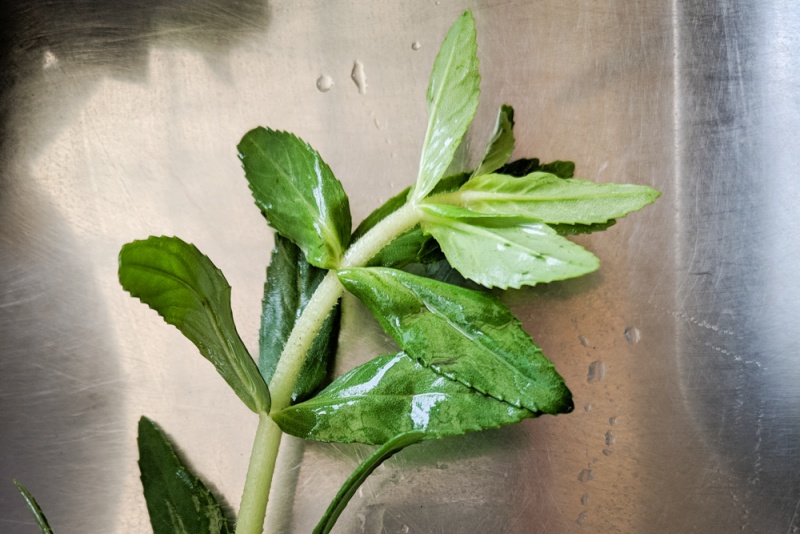
The rice paddy herb is another delicious herb that we have discovered in Vietnam. The flavor is a mixture of lemon and dill or perhaps cumin. In fact, some people refer to it as “sweet cumin”.
The easiest way to identify the rice paddy herb is by the small hairs on the stem. The herb’s stem is also hollow making it a bit squishy feeling when you pick it up. You can also look for the slightly serrated leaves. If you’re lucky, you’ll get some rice paddy herb served alongside your pho (phở) in Saigon and other parts of southern Vietnam.
Chinese Chives – Hẹ
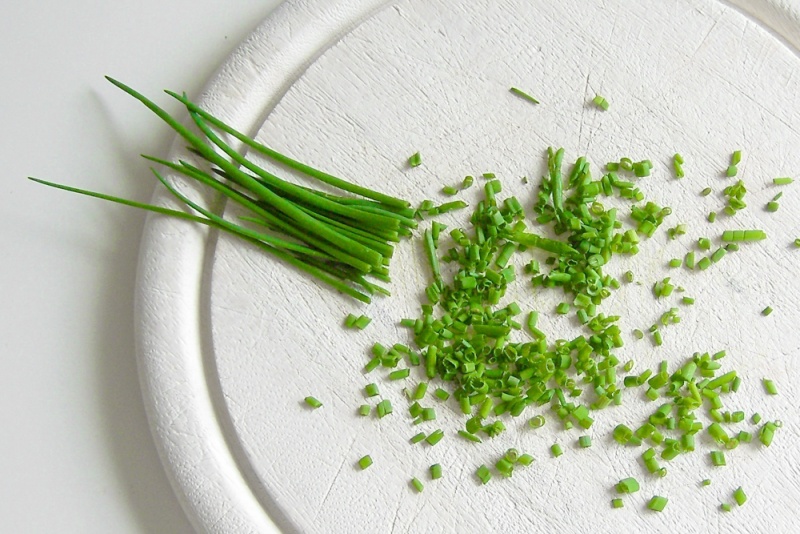
The Chinese chives, also called garlic chives, are quite common in Vietnamese cuisine. They have long thin stems just like green onions, and a similar flavor, but Chinese chives are a bit tougher. They’re a very common addition to pho (phở) in Northern Vietnam. You’ll certainly see them sticking out of your fresh rolls (gỏi cuốn).
Bitter Herb – Rau Đắng
Bitter herb tastes, well, very bitter. It’s primarily served alongside hotpots so you can add it if you want some extra bitterness in your broth.
At first glance, bitter herb looks a lot like paddy herb, but on closer inspection, they are actually quite different. First of all, the bitter herb is smaller. Second, the leaves have smooth edges rather than serrated. And finally, the stem is not hollow and is smooth rather than hairy.
It’s doubtful you’ll come across bitter herb unless you’re at a hotpot restaurant. It’s not very good eaten raw so you’ll want to make sure you let it cook down in the hotpot broth before consuming it.
Pennywort – Rau Má
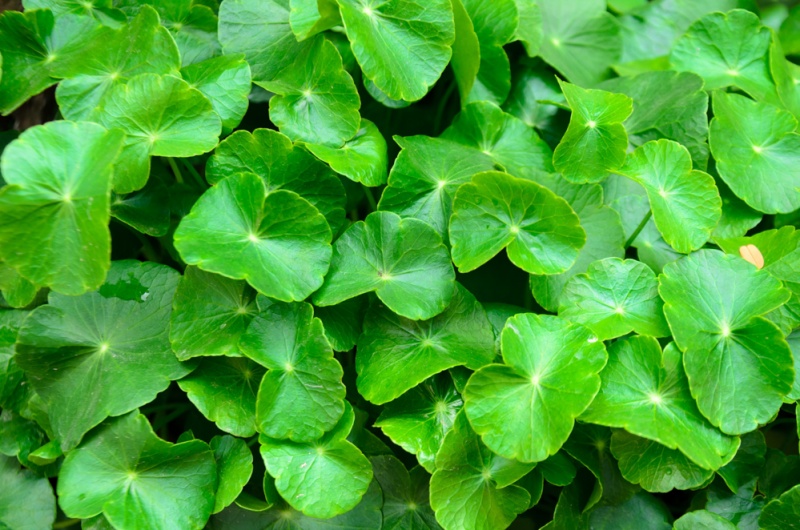
The pennywort has small round leaves that are easy to spot and taste a bit like a cucumber. You’ll find it occasionally wrapped up in fresh rolls (gỏi cuốn) or mixed into Vietnamese salads.
Also, if you’re one of those health nuts that love sludgy green smoothies full of wheatgrass and spinach, then you’re bound to love Vietnam’s nước rau má – pennywort juice!
Vietnamese Lettuce – Xà Lách
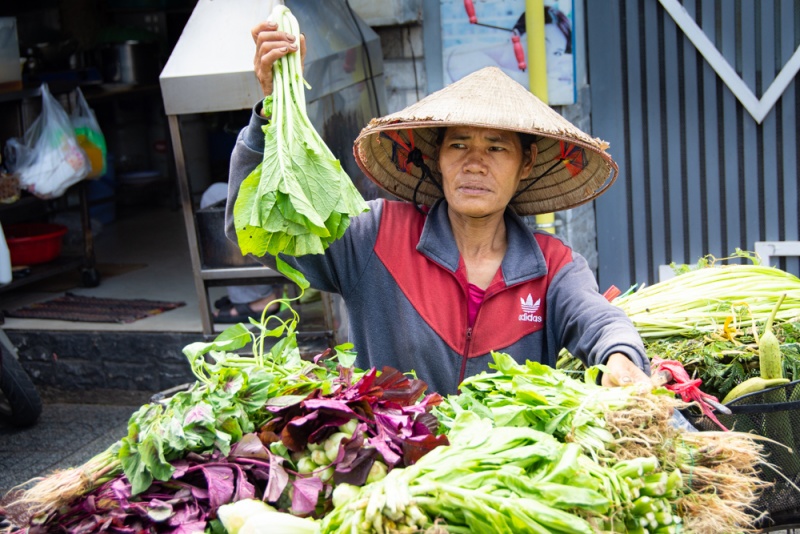
Lettuce is quite important in Vietnamese cuisine, especially for wrapping stuff up. In Saigon, banh xeo (bánh xèo) will typically be served with Vietnamese lettuce (which looks and tastes like Romain lettuce or Cos lettuce). Loose-leaf lettuce (xà lách lô lô) is also quite common in Vietnam and you’ll occasionally see butterhead lettuce (xà lách mỡ) used for lettuce wraps.
You should have no problem identifying lettuce as the varieties commonly used in Vietnam are quite similar to those in the USA and Europe.
Mustard Leaf – Cải Bẹ Xanh
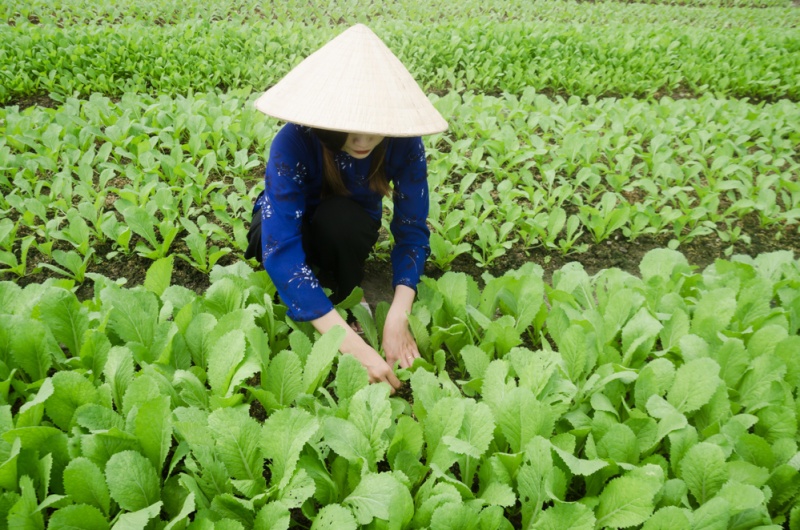
If you eat banh xeo (bánh xèo) in Saigon, you’ll probably encounter mustard leaves in your pile of herbs. It looks similar to lettuce, but the mustard leaf is round and flat with sharply serrated edges.
A common technique for rolling up banh xeo is to start with a big piece of lettuce, then add a large mustard leaf, and finish by piling on the smaller herbs and pieces of the banh xeo itself.
Shredded Water Spinach – Rau Muống
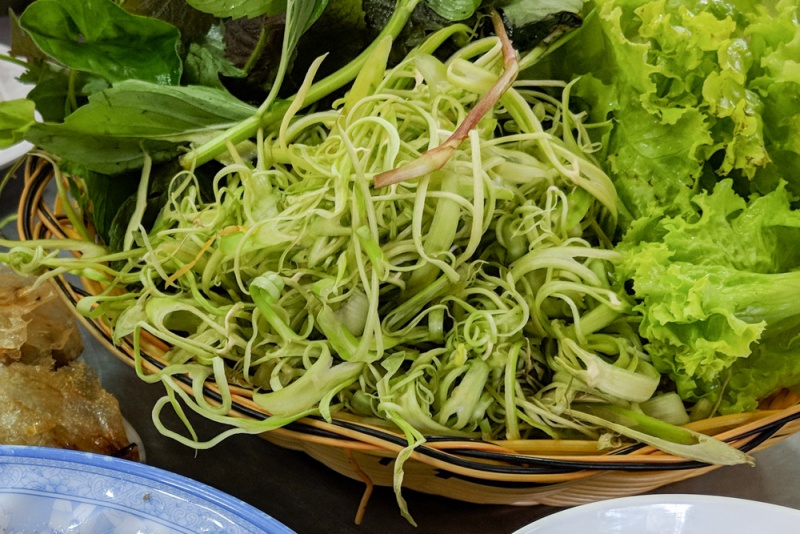
While not exactly a herb, shredded water spinach (also called morning glory) is commonly served alongside noodle soups in Vietnam. Look for it with bun rieu (bún riêu) and bun bo hue (bún bò huế) as well as with bun cha (bún chả).
Water spinach doesn’t have a lot of flavor on its own but is added to the soup to provide a crunchy texture. You’ll have no trouble with the identification of shredded water spinach – it’s the pile of curly thin green stuff next to your bowl of soup.
Shredded Banana Blossom – Bắp Chuối Bào
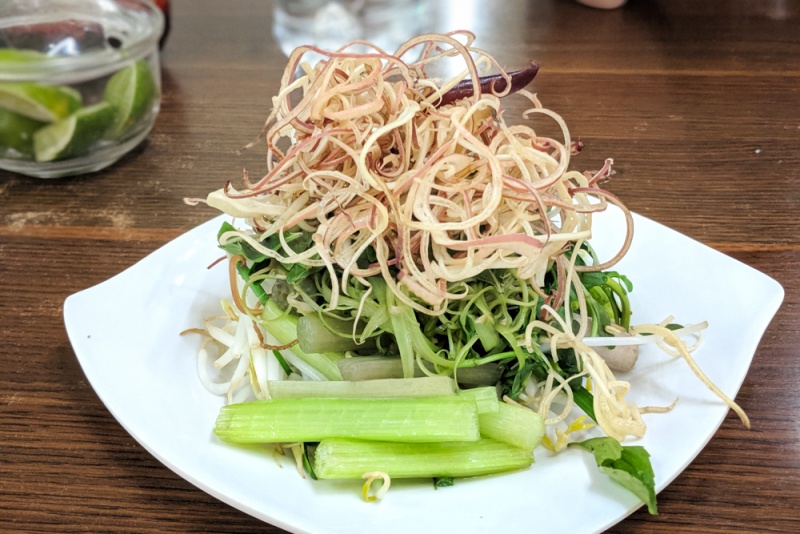
Just like water spinach, shredded banana blossom (or banana flower) is a very common addition to seafood soups, such as bun rieu (bún riêu) or bun mam (bún mắm). It’s also easy to identify as it is thin and curly with a white center and yellowish-pink edges.
As with water spinach, the addition of shredded banana blossom to your soup is more about texture than flavor. That being said, the banana blossom has a sweeter flavor than water spinach which is a little bit bitter.
Piper Lolot – Lá lốt
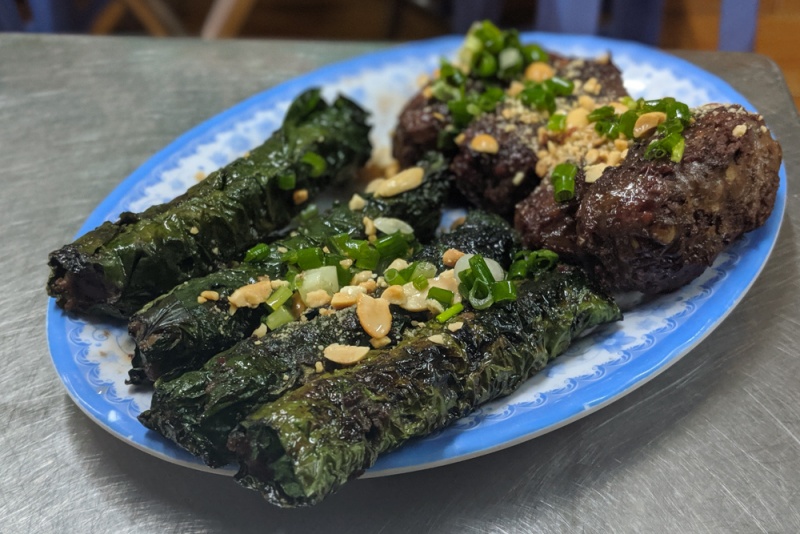
Piper lolot, also known as wild pepper or piper sarmentosum, is often mistranslated to “betel leaf” on menus in Vietnam. Betel leaf (lá trầu) is used for chewing betel nut in countries like Vietnam, Myanmar, and China and has a peppery, bitter flavor.
Piper lolot, on the other hand, is an herb commonly found in cuisine in Vietnam and other Southeast Asian countries. It also has a peppery taste but without the bitterness of betel leaf. It is also much thinner and more delicate. If you see a dish listed on a menu in Vietnam that claims to use betel leaf, they also certainly mean piper lolot.
Piper lolot is a key ingredient in one of our favorite street foods in Saigon – bo la lot (bò lá lốt). In this delicious snack, the piper lolot leaf is wrapped around a small beef sausage and then cooked on an open charcoal grill. The charcoal flame releases the delicate herbal flavor from the piper lolot that pairs perfectly with the seasoned beef.
Now you’re fully prepared to flavor your food with heaps of fresh Vietnamese herbs. Bon Appetit!
SHARE THIS ON PINTEREST
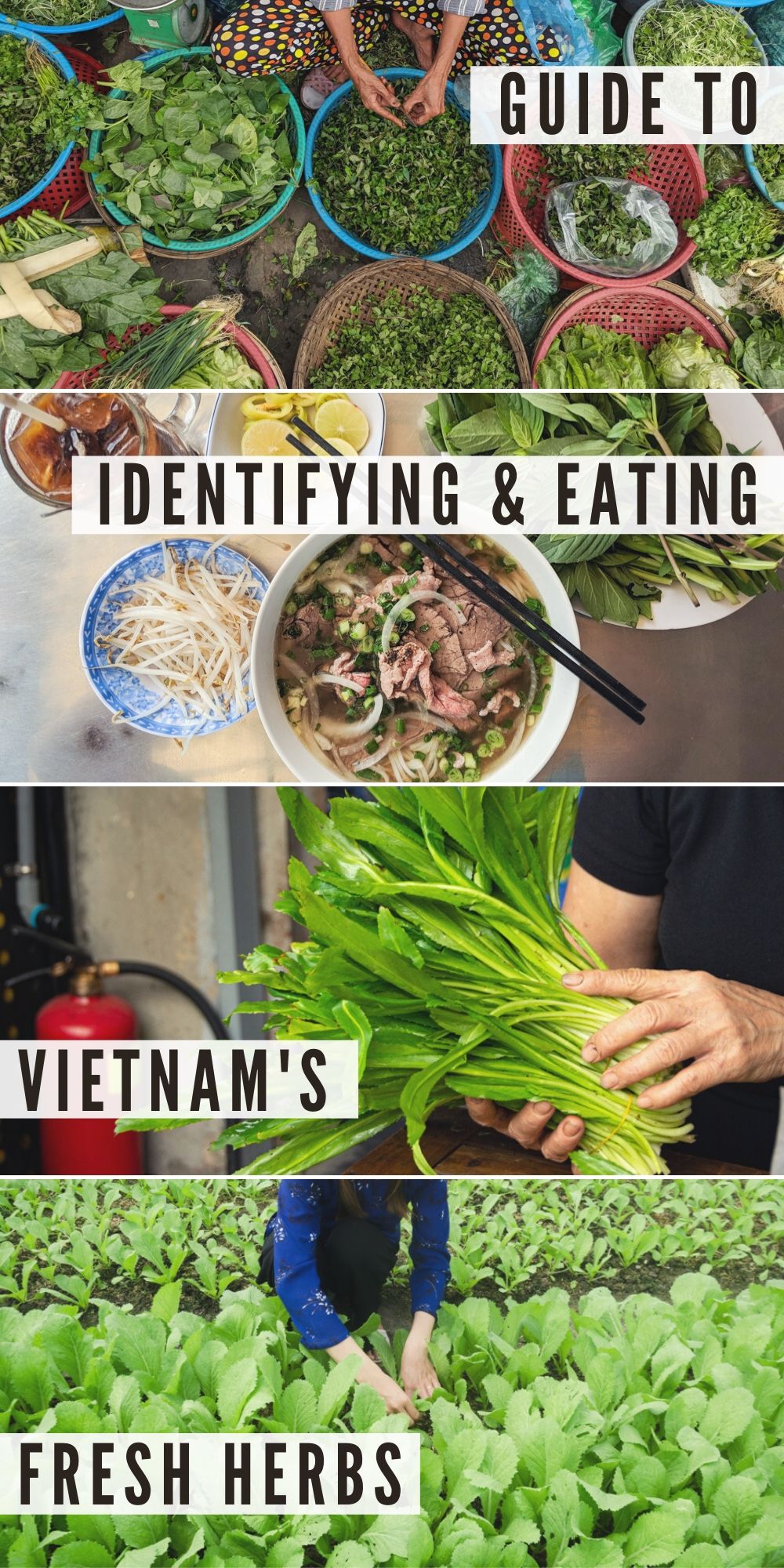

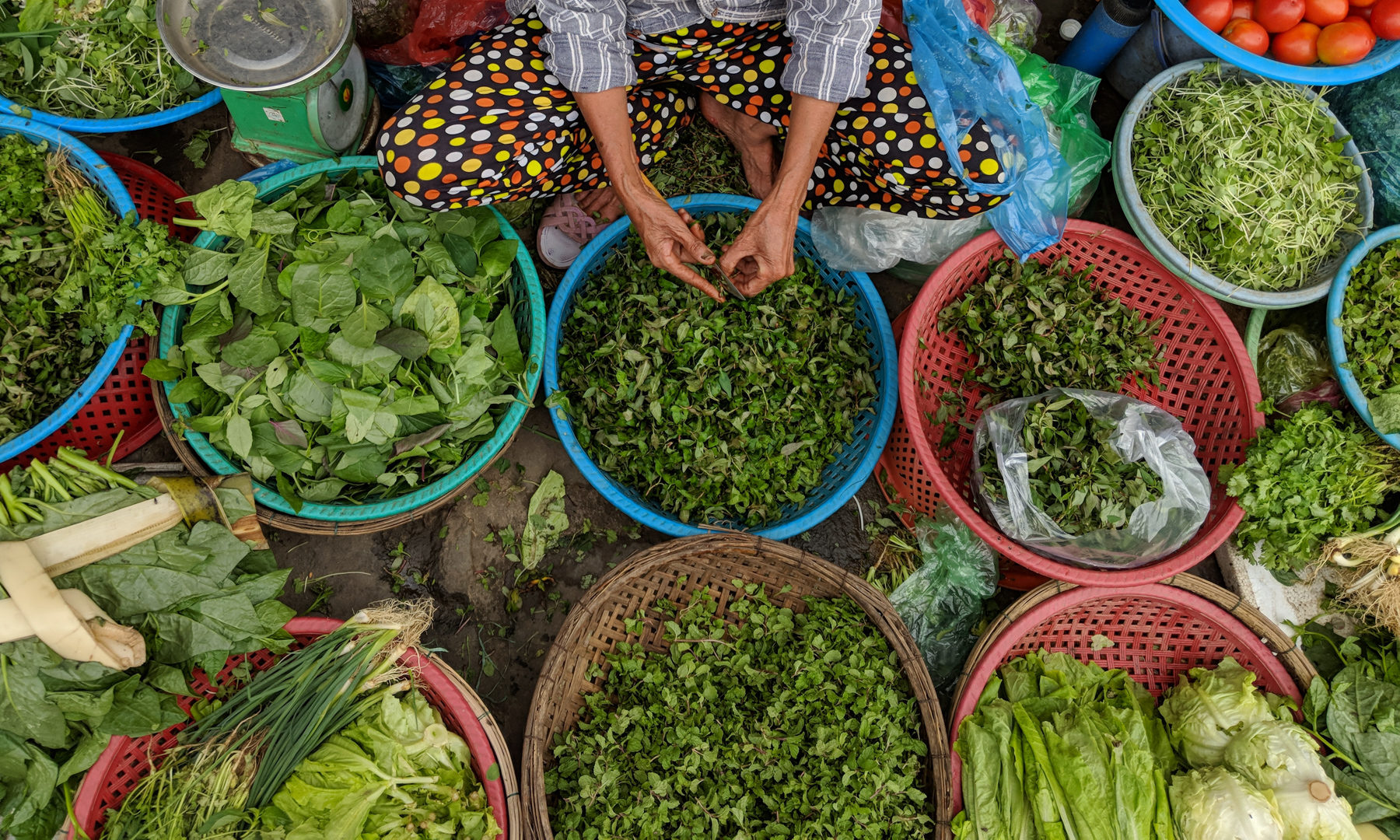


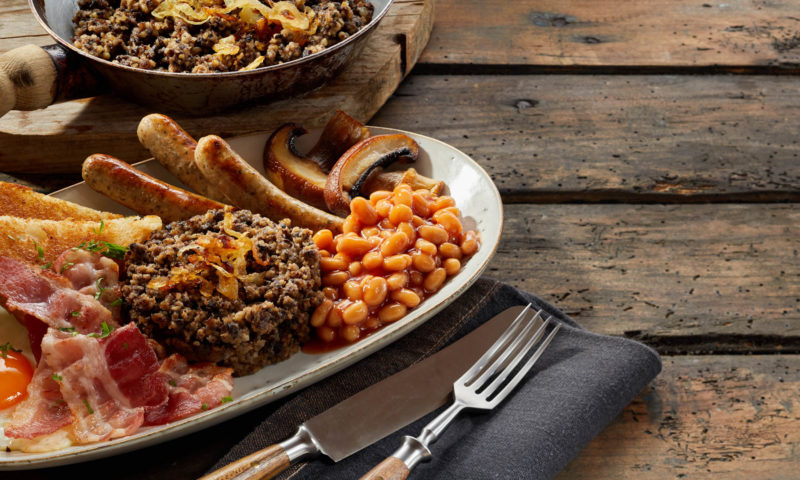

excellent info keep it going
Best, detailed article I’ve found so far regarding all of the herbs I grew up with! I’ve been trying to identify a few since I’ve moved to the mid southwest from the west coast. Now I understand why my parents grew their own garden as all of these herbs make any Vietnamese dish all the better! Thank you for this!
Great article. I read with interest having been in Vietnam often, but learned plenty. I was drawn to the piece by my search for xa hu’o’ng which is the translation I got for THYME. I wonder if you’d come across it in Vietnam. Cheers!
This is hands down the most comprehensive guide online out there on the salad / leaves / ingredients we had in our food when we visited HCMC and also in the many visits to Vietnamese restaurants in Singapore that followed afterwards…. thanks to your guide I can show them what I’d like to buy in the local Vietnamese mini mart here! Thank you!
“ngo gai” smell like bed bugs.
I would love to visit rural Vietnam I watch alot of off the grid living I just love their work and cooking ,wish I would have raised my children there ,I wish so much thT I had a friend to talk to from their that speaks English if I thought they would welcome me being a black American I would go I love the quiet off the grid living ,love it.why do that not build there homes to the ground and have so much open air ?????